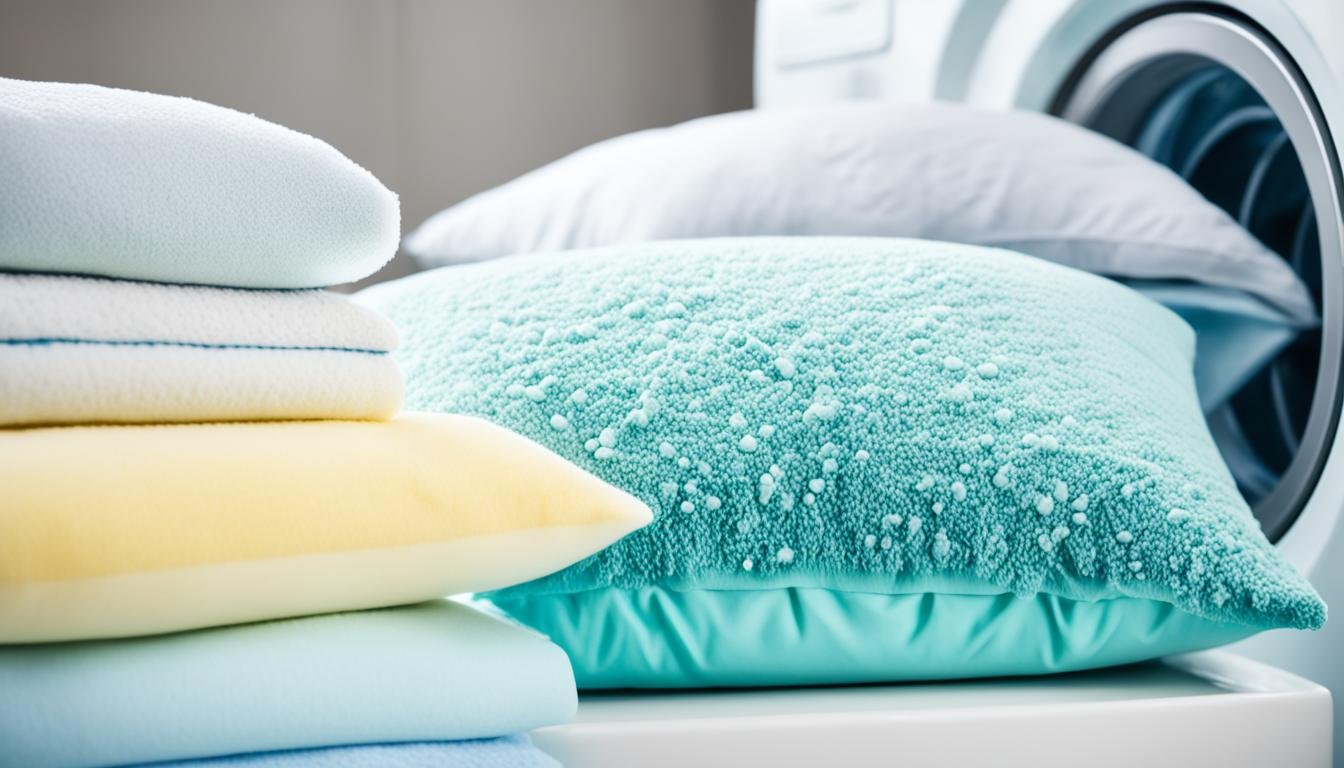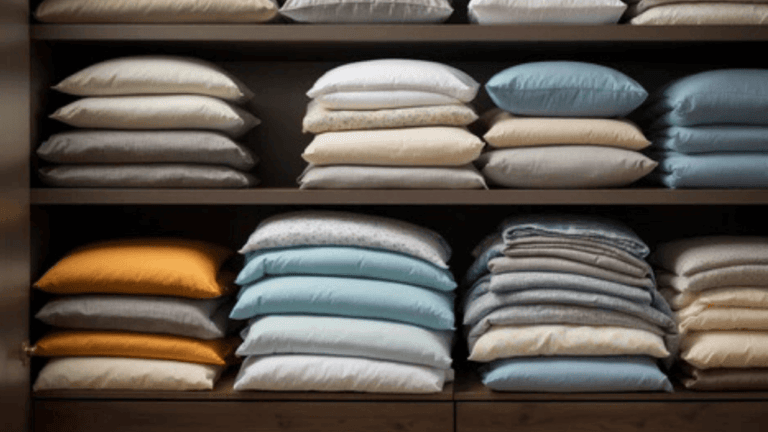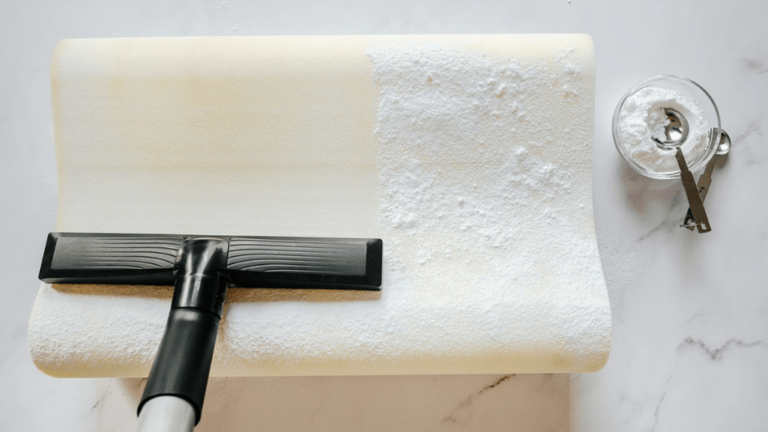Cleaning your pillows is crucial for both hygiene and a good night’s sleep. Knowing how to wash a pillow correctly might seem simple. But it gets complicated with different materials and cleaning instructions. Whether it’s soft down or firm memory foam, each pillow type has its own care needs. This article offers cleaning tips for various pillows to keep your sleeping area clean and refreshing.
To properly wash a pillow, just throwing it in the machine won’t cut it. You have to know the pillow’s specific needs and follow the right steps. With these care tips, you can keep your pillows as fresh and comfortable as when you first got them.
Key Takeaways
- Understanding the proper techniques to wash a pillow properly can significantly affect its lifespan and your health.
- Pillow washing instructions vary by type; knowing your pillow’s material is key to effective cleaning.
- Pillow care tips are designed to help you navigate the specifics of cleaning different pillow types.
- Adequate cleaning advice ensures the removal of allergens and bacteria, contributing to better sleep quality.
- Discover how to clean a pillow with confidence by following tailored, expert guidance.
- Practical insights into when and how to wash your pillows aid in maintaining their fluffiness and support.
Understanding Different Pillow Types and Their Care
Getting a good night’s sleep depends a lot on your pillow. With so many pillow types, it can be hard to know how to care for each one. Whether it’s the soft feather pillows you love or the firm memory foam that supports you, each needs proper pillow care to keep them in good condition.
Recognizing Your Pillow’s Material and Structure
Knowing your pillow’s material is the first step. Is it made from down feathers, memory foam, polyester, or latex? The type of material affects your comfort and how you should clean it. For instance, memory foam shouldn’t be put in the washing machine because it can get damaged. But, most machine washable pillows are made with synthetic fibers that can handle washing.
Decoding Care Tags: Following Manufacturer Guidelines
The care tags on your pillows are super important. They give you cleaning tips straight from the people who made them. These instructions can include how to wash them, how to spot clean, or if they need dry cleaning. They might also tell you the right settings for washing and drying. Following these tips helps keep your pillows in good shape.
Distinguishing Between Machine Washable and Dry Clean Only Pillows
Knowing if your pillow should be dry cleaned or can be washed is key. Pillows you can wash at home are handy, but some need dry cleaning because they’re delicate. Always look at the care label. Washing a pillow that’s not meant for it can ruin it, making it lumpy and unusable.
Can You Wash a Pillow in a Machine? Safe Practices Explained
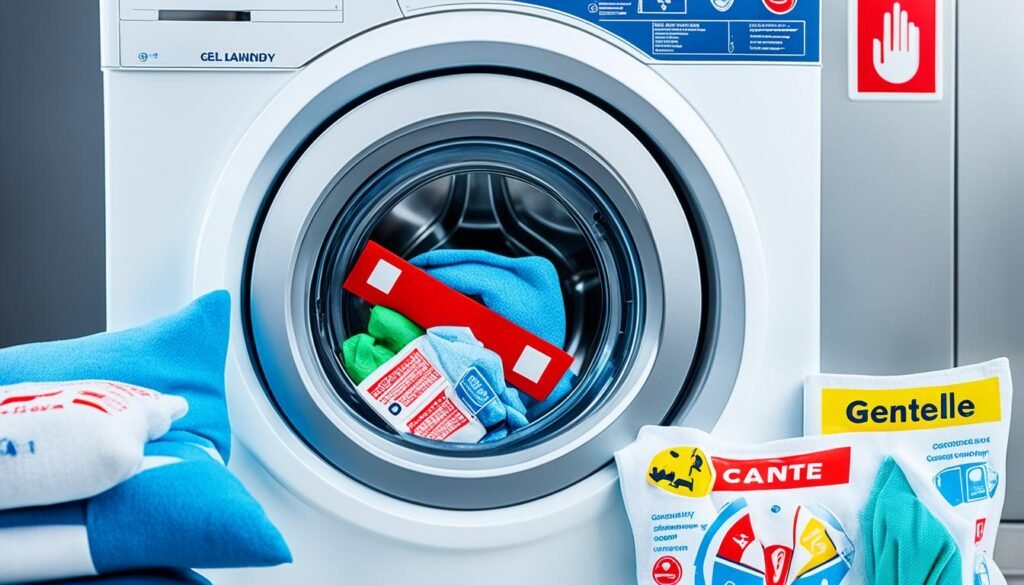
Many wonder if you can wash pillow in machine. The answer is yes, many pillows can go in the machine. This makes keeping your bedding clean and fresh easier. But, it’s important to follow safe practices to avoid damaging your pillows.
Machine washing can give pillows a deep clean. It removes dust mites, sweat, and oils. But, not all pillows should go in the machine. Always check the care label first. When the label says machine washing is okay, follow these safe practices:
- Use a gentle detergent and a delicate cycle with warm water. This helps protect your pillow.
- Wash two pillows at once to balance the machine. This prevents damage and keeps pillows in shape.
- Squeeze out air before washing. This ensures pillows get fully cleaned and wet evenly.
- Add an extra rinse cycle to get rid of all detergent. This stops irritation on your skin.
Knowing how to wash pillow in machine properly can make your sleep space cleaner and allergy-free. While risks like clumping or shrinking exist, they’re avoidable. Stick to safe practices to keep machine washing pillows a safe part of home care.
Hand-Washing Pillows: A Step-by-Step Guide
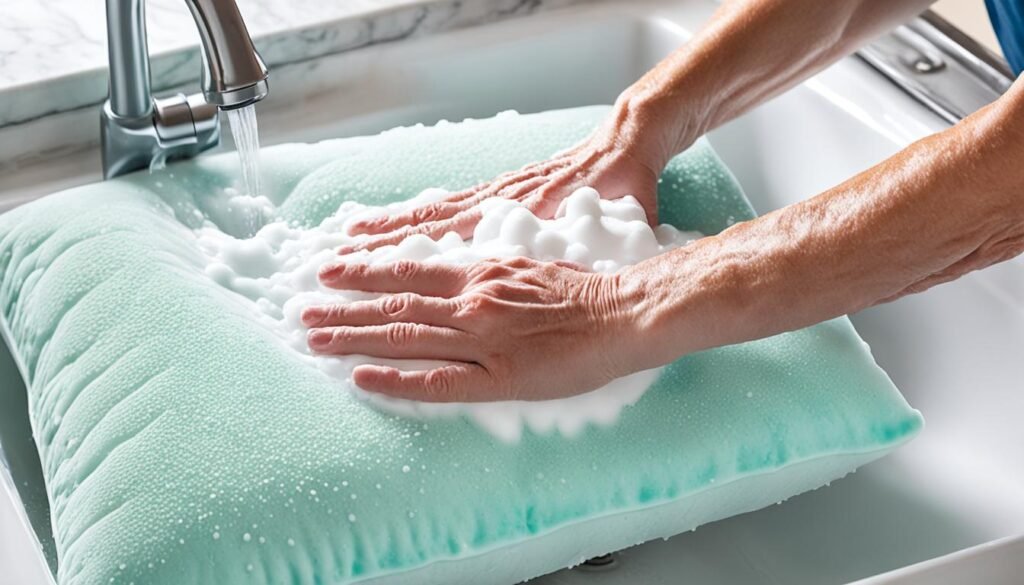
Hand-washing non-machine washable pillows keeps your bedding fresh and long-lasting. It’s key for items like memory foam pillows. These pillows need special care to stay comfy and supportive.
Hand-Washing Memory Foam Pillows for Longevity
Memory foam pillows shape to your head and neck but require care. To wash them, soak in lukewarm, soapy water. Don’t wring them out, as it harms the foam.
Rinse until the water is clear. Press out water gently. Let the pillow air dry completely.
Tips on Caring for Non-Machine Washable Pillows
Caring for delicate pillows, like down or feather, needs gentleness. First, take off any covers. Brush off dust, then spot clean with mild soap.
To wash, use lukewarm water and soap in a basin. Agitate gently, rinse well, and press out water without wringing. Dry them in a breezy place or in the sun.
- Always use lukewarm water for hand-washing pillows
- Avoid harsh chemicals; opt for gentle, pillow-friendly detergents
- Never wring or twist memory foam or delicate pillow types
- Ensure complete drying to prevent mold or mildew in your memory foam pillow care
Properly washing and caring for your pillows keeps them in top shape. This also makes your sleep space cleaner and allergen-free. Embrace these steps for a noticeable improvement in your home and health.
Spot Cleaning Pillows: Techniques to Remove Stains
Accidental spills and spots on pillows are not just unsightly. They are also a breeding ground for bacteria. Learning the art of spot cleaning pillows can be a lifesaver. It allows you to remove stains from pillows without washing them fully. This method focuses on the stained area only, making your bedding maintenance easy.
Got a coffee spill or an ink blotch? Here are some effective ways to tackle pillow stains:
- For common stains, mix mild dish soap with warm water. Use a white cloth to dab it on to avoid dye transfer.
- For stains from sweat or blood, try an enzyme cleaner. Its strength in breaking down proteins makes it super effective.
- For oily stains, pre-treat with baking soda. It helps absorb the stain before you spot clean.
Quick action is crucial in removing stains from pillows. Here’s how to act fast:
- Scrape or blot away any excess residue from the stain.
- Test your cleaner on a small, hidden part of the pillow for safety.
- Apply the cleaner gently, starting from the edges of the stain and moving inward.
- Rinse by blotting with a damp cloth, then dry with another cloth.
Keeping your pillows clean is not just about spot cleaning. Prevention is key. Use pillow protectors and change pillowcases often to reduce cleaning needs. But if you do get a stain, spot cleaning offers a quick fix. By following these care tips, you’ll enjoy both refreshing sleep and pillows that last longer and stay clean.
Pillow Washing Instructions: Best Practices for Machine Washing
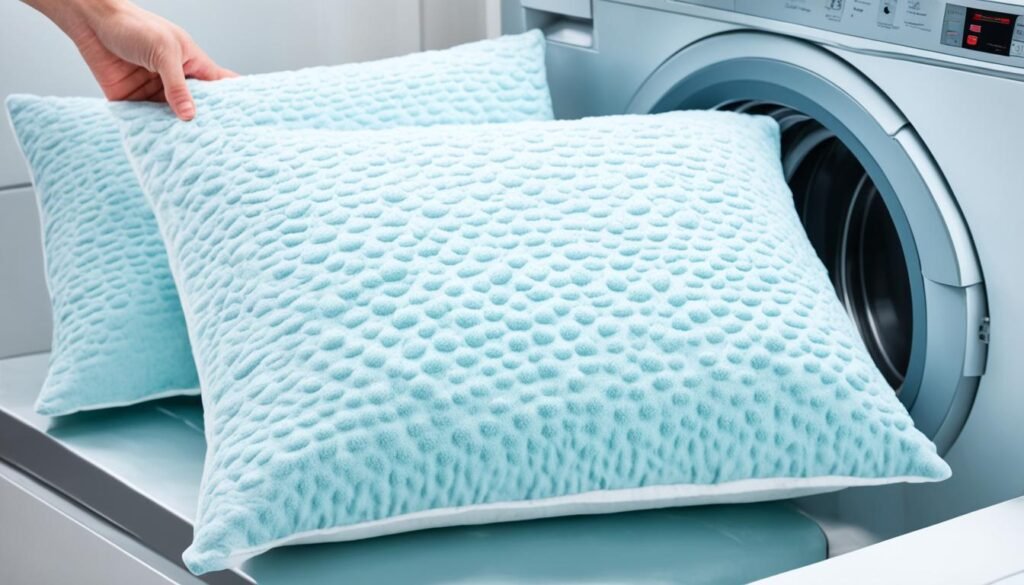
Clean, well-maintained pillows are key to your comfort and health. When machine washing pillows, knowing the right steps can make them last longer. From prepping to picking the right detergent and cycle, each step is important for pillow care.
Preparation Steps Before Machine Washing Pillows
Before you start, you need to do a few things:
- Check the care label to confirm if your pillow is machine washable.
- Remove any pillow covers or protective cases.
- Inspect the pillow for rips or tears and mend them to avoid filling spillage.
- Pre-treat any stains by gently applying a stain remover to the affected areas.
Choosing the Right Detergent and Cycle for Pillow Fabrics
- Select a mild detergent that is suitable for the pillow’s fabric type.
- Opt for a gentle cycle with warm water to safeguard the pillow’s integrity.
- Consider adding an extra rinse cycle to ensure all detergent residues are fully eliminated.
Ensuring Even Distribution: Washing Pillows in Pairs
To keep your washing machine balanced, wash pillows in pairs. This helps clean them evenly. If possible, position pillows vertically for better water and detergent flow. A simple but key step for top-notch pillow care.
Machine Wash Pillow Techniques: Protecting Pillow Integrity
Ensuring your pillows last starts with machine wash pillow techniques. These focus on keeping structure and comfort. Knowing how to protect pillow integrity during washing is key. Find practical pillow washing tips here to keep them in top shape.
Remember, not all pillows are the same. You must know the specific care they need based on material. Using the right cleaning methods protects your pillows.
- Always check the care label for manufacturer’s cleaning instructions to protect pillow integrity.
- Remove and wash any pillow covers separately. This gets them clean and reduces wear on the pillow itself during the wash.
To machine wash pillows right, follow these tips:
- Choose a gentle detergent and a delicate cycle to ease stress on fabric and fill.
- Wash two pillows together or add towels to balance the load. It prevents damage to pillows and washer.
- Opt for warm or cold water. Hot water might shrink or damage the fabric.
- Make sure pillows are rinsed well. Soap residue can attract dirt inside the pillow.
Using these machine wash pillow techniques protects pillow integrity. It also helps maintain your sleep hygiene. Washing regularly with our pillow washing tips extends pillow life. Enjoy peace and comfort every night.
Drying Pillows Correctly to Prevent Damage and Mildew
After washing your pillows, drying them the right way is just as important. Drying methods matter a lot to prevent pillow damage. They also stop mildew from growing. For any pillow, from delicate memory foam pillow drying to standard cushions, there are good methods. These ensure pillows are fresh, clean, and fluffy.
Methods to Dry Memory Foam and Other Specialty Pillows
Memory foam and other special pillows need extra care. Their unique materials can’t handle high heat or direct sunlight. Here’s what you should do:
- Lay the pillow flat on a clean, dry towel away from direct sunlight or heat sources to prevent mildew.
- Pat down gently with another towel to absorb as much moisture as possible.
- Let the pillow air dry fully, flipping it now and then for even drying methods.
How to Fluff Pillows Post-Dry: The Role of Dryer Balls
Fluffing pillows after they dry is crucial for their shape. Dryer balls help, even with air-dried pillows:
- Put the pillow and a few wool dryer balls in the dryer on a no-heat, air-fluff setting.
- The dryer balls bounce and agitate the fill, which helps pillow fluffing.
- Take out the pillows occasionally and fluff them by hand to get an even fluffiness.
Patience and the right steps are vital. They prevent pillow damage and make your bed cozy and inviting. This promises good sleep.
Pillow Care Tips for Ongoing Maintenance
Keeping your pillows fresh needs regular work. It’s not just something you do now and then; it involves ongoing pillow maintenance. By staying on top of it, your pillows will last longer. They’ll also be comfy and clean. Let’s look at some easy pillow care steps to add to your daily routine.
Implementing Regular Pillow Fluffing into Your Routine
Regular pillow fluffing keeps them comfy and full. Make it something you do every day. This stops the filling from getting lumpy and keeps it spread out nicely. Here are simple ways to fluff your pillows daily:
- Shake your pillows from end to end to break up the fill.
- Squeeze the pillows from both sides, then turn and do it again.
- If they’re still not fluffy enough, toss them in the dryer. Use a low heat setting and dryer balls for a few minutes.
When to Opt for Professional Pillow Cleaning Services
Sometimes home cleaning isn’t enough. That’s when professional pillow cleaning comes in handy. Use it for tough stains, bad smells, or when you need a deep clean. Pros are good with different pillow types so there’s no damage. They know exactly what to do.
- Getting your pillows cleaned by a pro once a year can make them like new again.
- After being sick, a professional clean can kill any remaining germs.
- For those fancy down or feather pillows, pros can take special care of them.
Follow these pillow care tips, and your pillows will stay clean and keep their shape. You’ll sleep better knowing they’re in good condition.
Conclusion
We’ve gone through how to care for pillows in great detail in this guide. We learned what the symbols on care tags mean and how different materials need different care. Now, we know how to keep our pillows fresh and extend their life. Cleaning our pillows the right way means they’ll stay clean and supportive. This makes our sleep better.
Taking care of our pillows does more than keep them clean. It creates a place where we can rest and rejuvenate. This care reflects how much we value our own health. Using the tips we talked about isn’t just about keeping our house clean. It’s a way to take care of ourselves. With good pillow care, we make our sleep better, which is crucial for our health and how well we do every day.
It’s time to end our discussion about pillow care. But let’s remember what we learned. Washing our pillows right is a key part of keeping our home clean. The advice we shared is a guide to make our pillows last longer. Follow these tips and you’ll have a clean, comfy pillow every night. Just like when you first bought it.

